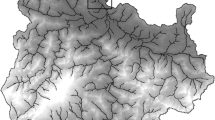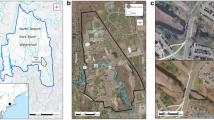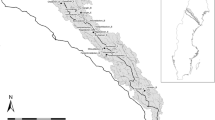Abstract
In-stream structures including cross-vanes, J-hooks, rock vanes, and W-weirs are widely used in river restoration to limit bank erosion, prevent changes in channel gradient, and improve aquatic habitat. During this investigation, a rapid assessment protocol was combined with post-project monitoring data to assess factors influencing the performance of more than 558 in-stream structures and rootwads in North Carolina. Cross-sectional survey data examined for 221 cross sections from 26 sites showed that channel adjustments were highly variable from site to site, but approximately 60 % of the sites underwent at least a 20 % net change in channel capacity. Evaluation of in-stream structures ranging from 1 to 8 years in age showed that about half of the structures were impaired at 10 of the 26 sites. Major structural damage was often associated with floods of low to moderate frequency and magnitude. Failure mechanisms varied between sites and structure types, but included: (1) erosion of the channel bed and banks (outflanking); (2) movement of rock materials during floods; and (3) burial of the structures in the channel bed. Sites with reconstructed channels that exhibited large changes in channel capacity possessed the highest rates of structural impairment, suggesting that channel adjustments between structures led to their degradation of function. The data question whether currently used in-stream structures are capable of stabilizing reconfigured channels for even short periods when applied to dynamic rivers.





Similar content being viewed by others
References
Bathurst JC (1997) Environmental river flow hydraulics, chap 4. In: Thorne CR, Hey RD, Newson MD (eds) Applied fluvial geomorphology for river engineering and management. Wiley, Chichester, pp 69–93
Bernhardt PMA, Alexander AJD, Barnas GK, Brooks S, Carr J, Clayton S, Daham C, Follstad-Shah J, Galat D, Gloss S, Goodwin P, Hart D, Hassett B, Jenkinson R, Katz S, Kondolf GM, Lake PS, Lave R, Meyer JL, O’Donnell TK, Pagano L, Powell B, Sudduth E (2005) Synthesizing US river restoration efforts. Science 308:636–637
Brookes A (1997) River dynamics and channel maintenance. In: Thorne CR, Hey RD, Newson MD (eds) Applied fluvial geomorphology for river engineering and management. Wiley, Chichester, pp 293–307
Brown K (2000) Urban stream restoration practices: an initial assessment. Final report for the US Environmental Protection Agency Office of Wetlands, Oceans and Watersheds, Region V
Frissell CA, Nawa RK (1992) Incidence and causes of physical failure of artificial habitat structures in streams of western Oregon and Washington. North Am J Fish Manag 12:182–197
Kondolf GM (2006) River restoration and meanders. Ecol Soc 11(2):42
Miller JR, Kochel RC (2008) Characterization and evaluation of stream restoration projects in North Carolina. Final report to the North Carolina Clean Water Management Trust Fund, Project No. 2002B-805
Miller JR, Kochel RC (2010) Assessment of channel dynamics, in-stream structures and post-project channel adjustments in North Carolina and its implications to effective stream restoration. Environ Earth Sci 59:1681–1692
Palmer MA, Bernhardt ES, Allan JD, Lake PS, Alexander G, Brooks S, Carr J, Clayton S, Dahm CN, Follstad Shan J, Galat DL, Loss SG, Kondolf GM, Lave R, Meyer JL, O’Donnell TK, Pagano L, Sudduth E (2005) Standards for ecologically successful river restoration. J Appl Ecol 42:208–217
Penrose D (2007) Evaluation of North Carolina stream restoration projects, biological responses to habitat change. USDA-CSREES 2007 National Water Quality Conference
Platts WS, Nelson RL (1985) Stream habitat and fisheries response to livestock grazing and in-stream improvement structures, Big Creek, Utah. J Soil Water Conserv 40:374–379
Puckett P (2007) The rock cross vane: a comprehensive study of an in-stream structure. Unpublished PhD dissertation, Dept of Biological and Agricultural Engineering, North Carolina State University, Raleigh
Puckett P, Jennings G (2007) Rock cross vane design. USDA-CSREES National Water Conference, Jan. 28, 2007; USDA-CSREES National Water Conference Abstracts Database
Roni P, Beechie TJ, Bilby RE, Leonetti FE, Pollock MM, Pess GR (2002) A review of stream restoration techniques and a hierarchical strategy for prioritizing restoration in Pacific northwest watersheds. North Am J Fish Manag 22:1–20
Roni P, Hanson K, Beechie T (2008) Global review of the physical and biological effectiveness of stream habitat rehabilitation techniques. North Am J Fish Manag 28:856–890
Roper BB, Konnoff D, Heller D, Wieman K (1998) Durability of Pacific Northwest in-stream structures following floods. North Am J Fish Manag 18:686–693
Rosgen DL (2001) The cross-vane, W-weir, and J-hook vane structures: their description, design and application for stream stabilization and river restoration. Proceedings of ASCE conference on wetlands engineering and river restoration, Reno, NV, pp 1–22
Rosgen D (2006) The cross-vane, W-weir, and J-hook vane structures (updated 2006). Description, design and application for stream stabilization and river restoration. Wildland Hydrology, Inc. http://www.wildlandohydrology.com. Accessed December 2007
Shields FD Jr, Morin N, Cooper CM (2004) Large woody debris structures for sand bed channels. J Hydraul Eng 130(3):208–217
USEPA (1989) Nonpoint sources: agenda for the future. Technical Report WH-556, US Environmental Protection Agency, Office of Water
USEPA (1999) Definitions and distinctions. River corridor and wetland restoration principles. United States Environmental Protection Agency. http://www.epa.gov/owow/wetlands/restore/defs.html. Accessed online December 2007
USGS (2009a) USGS real-time water data for North Carolina. http://waterdata.usgs.gov/nc/nwis/rt. Accessed May 2007 to December 2009
USGS (2009b) North Carolina flood frequency statistics. http://nc.water.usgs.gov/flood/floodstats/gaged/basins.html. Accessed May 2007 to December 2009
Williams JE, Wood CA, Dombeck MP (1997) Watershed restoration: principles and practice. In: Williams JE, Wood CA, Dombeck MP (eds) American Fisheries Society, Bethesda, Maryland
Acknowledgments
This project was funded by a grant from the North Carolina Clean Water Management Trust Fund under Project Number 2002B-805. Without their support this project would not have been possible. A large number of students aided in the collection and manipulation of data for this project, and their efforts are greatly appreciated. They include Heather Gregory, Adam Hunter, Benjamin Jackson, Patrick Jarrett, David Huffstetler, Nate Irwin, and Michelle Pederson. We are also indebted to Jessica Jaynes, who possessed the organizing skills and work ethic to convert a pile of documents into a functioning database. Thanks also go to Chris Tennant for countless hours of manipulating monitoring records, Eric Neff for host of activities, including the analysis of database and hydrologic records, and Gary Nottis for his work with GIS and basin morphometry. We also thank four anonymous reviewers who greatly improved the presentation of the manuscript.
Author information
Authors and Affiliations
Corresponding author
Electronic supplementary material
Below is the link to the electronic supplementary material.
Rights and permissions
About this article
Cite this article
Miller, J.R., Craig Kochel, R. Use and performance of in-stream structures for river restoration: a case study from North Carolina. Environ Earth Sci 68, 1563–1574 (2013). https://doi.org/10.1007/s12665-012-1850-5
Received:
Accepted:
Published:
Issue Date:
DOI: https://doi.org/10.1007/s12665-012-1850-5




